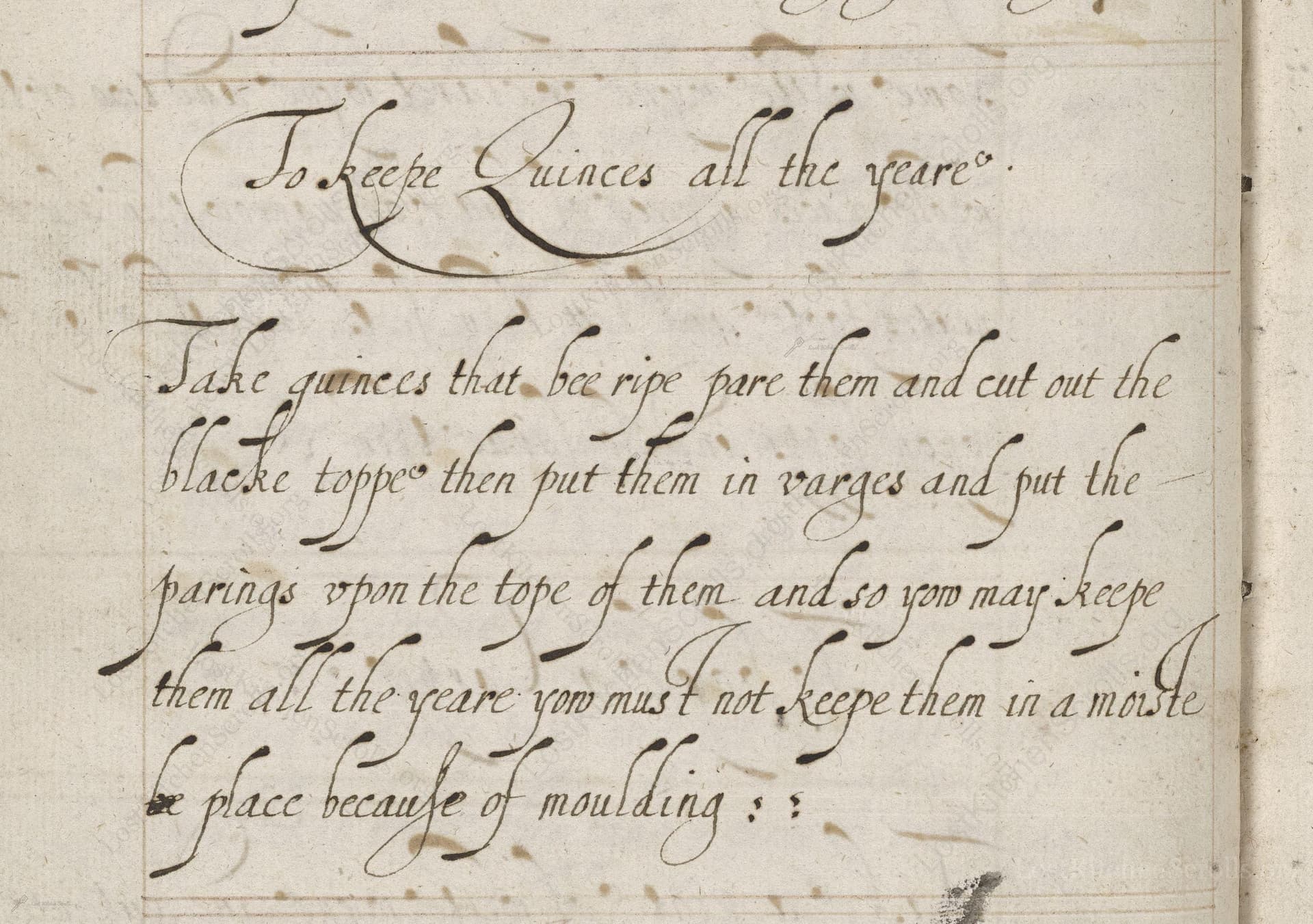To Keepe Quinces All The Yeare
From the treasured pages of Medicinal and cookery recipes by John King
Written by John King

To Keepe Quinces All The Yeare
"Take quinces that bee ripe pare them and cut out the blacke toppe then put them in varges and put the parings vpon the tope of them and so you may keepe them all the yeare, you must not keepe them in a moiste place because of moulding ::"
Note on the Original Text
The recipe is concise and practical, reflecting the matter-of-fact style of early modern cookery books. Instructions are brief, assuming a level of kitchen experience and familiarity with terms like 'blacke toppe' (the blossom end). Spelling was fluid in this period—'varges' means jars, and 'keepe' is 'keep.' The minimal detail shows the intended audience knew preservation basics, focusing on the vital points: cleanliness, dryness, and the exclusion of moisture to avoid spoilage.

Title
Medicinal and cookery recipes by John King (1675)
You can also click the book image above to peruse the original tome
Writer
John King
Era
1675
Publisher
Unknown
Background
A delightful journey into the kitchens of the 17th and early 18th centuries, this collection, attributed to John King, brims with time-honored recipes, culinary wisdom, and flavors that once graced historic tables.
Kindly made available by
Folger Shakespeare Library
This recipe hails from early modern England, roughly between 1625 and 1725, attributed to John King. In this time, quinces were prized for their fragrance and keeping qualities, often stored to be enjoyed during the long winter months when fresh fruit was scarce. Recipes like this one were shared among households keen on food preservation, reflecting a time before widespread refrigeration. Preserving methods relied on careful preparation and clever techniques to extend seasonal bounty throughout the year.

Back in the 17th and early 18th centuries, the tools would have been simple: a sharp kitchen knife or paring knife for peeling and coring, perhaps a small spoon to scoop any seeds, and sturdy ceramic or earthenware vessels ('varges' refers to such storage pots). Clean linen or paper might be used to cover the jars, and cool larders or pantries provided the optimal storage environment.
Prep Time
20 mins
Cook Time
0 mins
Servings
8
We've done our best to adapt this historical recipe for modern kitchens, but some details may still need refinement. We warmly welcome feedback from fellow cooks and culinary historians — your insights support the entire community!
Ingredients
- 4 1/2–6 1/2 lbs ripe quinces (Cydonia oblonga)
- Clean, dry ceramic or glass jars or crocks
- No water or preservatives required
Instructions
- Select ripe quinces (preferably fragrant and with yellow skin).
- Peel the quinces and remove the 'black top,' which refers to the blossom end.
- Place the prepared quinces in clean, dry ceramic or glass jars, packing them closely together.
- Cover the quinces with their own peelings as a natural barrier against air.
- Store the jars in a cool, dry, and well-ventilated area—avoid damp locations to prevent the formation of mold.
- Stored this way, quinces can last for many months, providing delicious fruit throughout the year.
Estimated Calories
50 per serving
Cooking Estimates
You only need a few minutes to peel and prepare the quinces before storing them. No cooking is needed. Each stored quince is about 50 calories, and a jar usually fits 8 quinces.
As noted above, we have made our best effort to translate and adapt this historical recipe for modern kitchens, taking into account ingredients nowadays, cooking techniques, measurements, and so on. However, historical recipes often contain assumptions that require interpretation.
We'd love for anyone to help improve these adaptations. Community contributions are highly welcome. If you have suggestions, corrections, or cooking tips based on your experience with this recipe, please share them below.
Join the Discussion
Rate This Recipe
Dietary Preference
Main Ingredients
Culinary Technique

Den Bockfisch In Einer Fleisch Suppen Zu Kochen
This recipe hails from a German manuscript cookbook compiled in 1696, a time whe...

Die Grieß Nudlen Zumachen
This recipe comes from a rather mysterious manuscript cookbook, penned anonymous...

Ein Boudain
This recipe comes from an anonymous German-language manuscript cookbook from 169...

Ein Gesaltzen Citroni
This recipe, dating from 1696, comes from an extensive anonymous German cookbook...
Browse our complete collection of time-honored recipes



